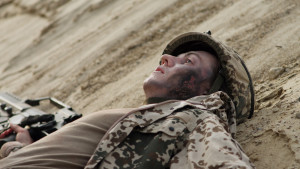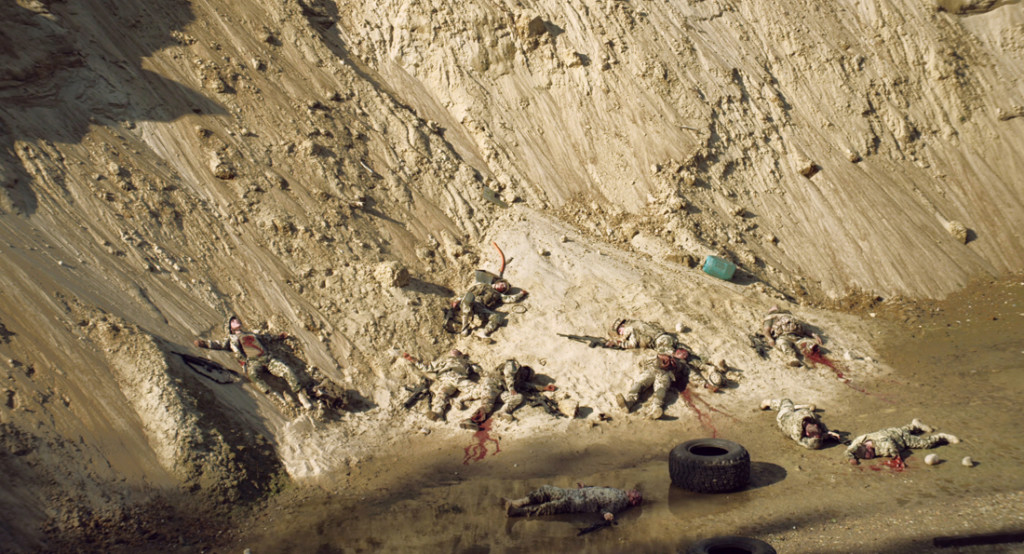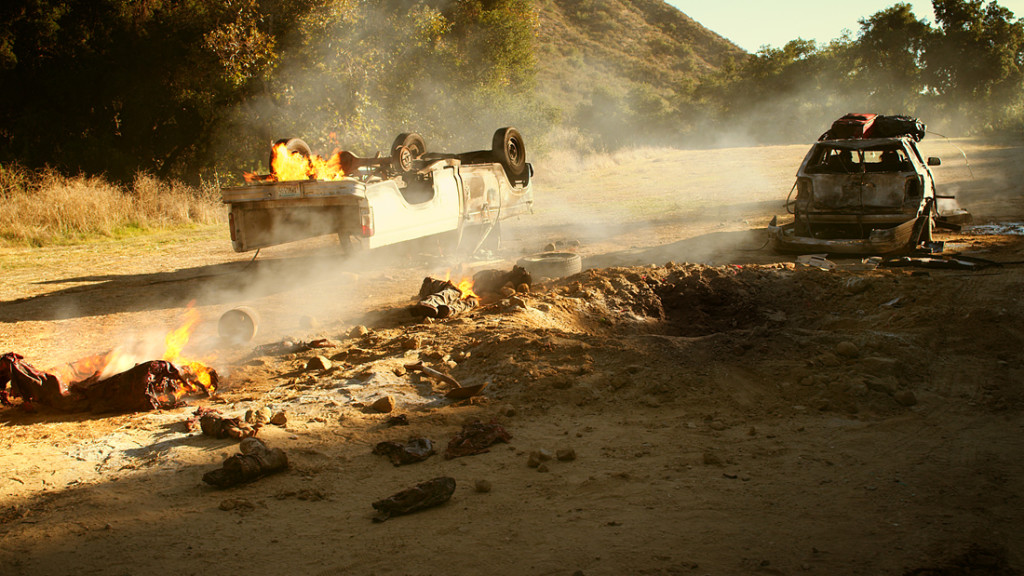
Fast aims to question the way a recollection can be a construction, rather than a fact. It gives him freedom to embrace complex storytelling, and as he interweaves the fantastical with the mundane his movies become confrontational, they question the humanity, or the lack of it, in today’s global conflicts.
Machteld Leij on the films of Omer Fast
Continuity (Diptych), 2012-2015.
The films of Omer Fast
PLAYING WITH NOTIONS OF HUMANITY
An old lady on the verge of dementia was one of the first characters of Omer Fast (1972, Jerusalem, lives and works in Berlin) I encountered. It was in Mechelen, Belgium, in 2007 on the video biennial ‘Contour’. An old lady told about her life in a film, staged as a play. It was also the story of a young woman, who took care of her, on a daily basis. Both women from different denominations seemed an unlikely couple. One stuck in the past and a smaller world, the other one with a family history rooted outside Europe.
*
It worked this bond between a growling old lady and a positive, happy younger one. Of course there was a clue, as the film was titled ‘De Grote Boodschap’, the Big Message. In Dutch, it is slang for a poo. That poo, as the lady tells her audience, consisted of all the valuable jewels she ate to hide them from the Nazis, which occupied Mechelen during World War II.
*
So there you are: humor and painful memories, mixed with the problems of today’s society: racism sometimes, misunderstandings, different ways of life that convincingly seem to be able to meet in the middle. This turned out to be a potent mixture that gave ‘De Grote Boodschap’ its significance.
Omer Fast tackles pain and unease, trauma even. And he does so in a heavy light-hearted fashion and has been doing so ever since, even when his camera swerves to often traumatised soldiers. I visit his exhibition in Jeu de Paume in Paris, just days after the terrorist attacks on café’s and the concert hall Bataclan. It’s the wounds that warfare leaves in all of society, that fuels Fasts films and somehow his work seems more urgent now. Born in Jerusalem, having spent his childhood in a conflicted society, you would instantly believe he is able to see well beyond uniforms, trained bodies and efficient machismo.
Continuity (Diptych), 2012-2015.
His exhibition in Paris it is a rather small exhibition of only four of his works. In his film ‘Continuity (diptych)’, 2012-2015, we meet a couple. They are to pick up their son coming back from fighting in Afghanistan. When at home, the young man’s teenage room seems too small, too much time has passed, too much has happened. We see flashbacks of a patrol under attack. Surreally induced by a scene in which his mother sees a dromedary that seems lost in between the leaf trees of Germany. It functions as a portal, and takes us right into the desert. In the distance soldiers lie, lifeless, bloodied and dismembered as an echo of Jeff Walls ‘Dead Troops Talk’. Their armoury is calmly collected by a young man in traditional robes.
Continuity (Diptych), 2012-2015.
It is a strange visual play, this movie. The couple gets to pick up their son in different embodiments, as if in a time-loop, as if all the possibilities of the universe are played out. One time shy and vulnerable, the next time sly and strangely making advances to either mum or dad. The suggestion is made, through little things they say, or strange reactions to one another, that these ‘Daniels’ hired male prostitutes. The scenes are entwined with other stories, one of another Daniel, ripping off his customer, stealing his car, and eventually killing Daniel the son, who didn’t go to Afghanistan, it seems. There are drug deals in the bakery, a baker turned rogue and a hideous accident, all in a relatively calm German neighbourhood, a far cry from the desert heat in Afghanistan.
*
This story wriggles and writhes, however it all comes together in an eternal loop. No final answers to the question what actually happened. There is no need, though, as Fast aims to question the way a recollection can be a construction, rather than a fact. It gives him freedom to embrace complex storytelling, and as he interweaves the fantastical with the mundane his movies become confrontational, they question the humanity, or the lack of it, in today’s global conflicts. The point-of-view in Fasts recent work is that of the western soldier. Not as a hero, but as a vulnerable human being. It is about his fears, anxieties and trauma’s, his identity and occasionally his love for other men.
Fast is a storyteller, rooted firmly in the realm of the real: so war, the news and actual interviews with drone pilots and soldiers are the elements he uses for his films. It’s actual reality he unravels into bits.
5000 Feet is the Best, 2011.
Repeating, deconstructing and adding other stories, urban legends for instance, anecdotes that seems to lead their own lives, with a phantasmagorical result. Such is the case in the other lengthy film shown in Jeu de Paume: ‘5.000 Feet is the Best. The film is centred around the recollections of a drone pilot, being interviewed in a impersonal hotel room, irritated sometimes, having a go at the interviewer: But you are not a real pilot? Well, you are not a real journalist. Talking about PTSS, popping pills and telling strange anecdotes. For instance the Californian family who leaves their house for an outing, driving for hours to get lost, all of a sudden in war zone, being bombed. Again, borders in Fasts realm are rather fluid. All of a sudden his protagonists could be out of place, literary.
5000 Feet is the Best, 2011.
In the catalogue Fast explained that growing up in two countries, never having a fixed unitary identity made him susceptible to obsessions with the double, reconstruction and loop. His choice for prostitutes, soldiers as protagonists allows him to cross borders, to deal with the provocative freedom of those that have one leg in civil society, the other in a spot with different moral codes.
It is a confronting freedom, in case of the soldiers at least, to use weapons, to fight, to kill. As an archetype, Fast questions them, let them unravel their emotions. And in doing so, the mythical creature of destruction and war becomes human again. The play with notions of humanity is elaborate. The personal and universal get mixed up in the films of Fast. Elements of the grotesque and a hint of actuality go together in a titillating way. And as a viewer, you’re puzzled, alarmed and touched at the same time. That state of paradox opens up minds.
Omer Fast, le present continue, in Jeu de Paume until 24th of January. The exhibition will travel to Baltic Centre (18/3 to 26/6) and Kunsten Museum of Modern Art, Aalborg (23/ 9 to 8/1 2017) in different constellations.
www.jeudepaume.org, www.balticmill.org, www.kunsten.dk
Courtesy: James Cohan Gallery
1. Marina Vinyes Albes, Interview with Omer Fast in exhibition catalogue ‘Omer Fast, Le present continue’, 2015, page 109
Machteld Leij is an art historian from Leiden. She works as an independent writer and critic. She publishes in several magazines in and outside of The Netherlands.




